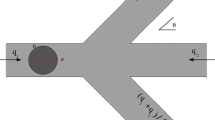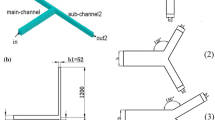Abstract
Motivated by the previous studies (Lee et al., Lab Chip 10:1160–1166, 2010; Link et al., Phys Rev Lett 92:054503-1–054503-4, 2004), the droplet dynamics passing through obstructions in confined microchannel was explored both numerically and experimentally. The effects of obstruction shape (cylinder and square), droplet size, and capillary number (Ca) on droplet dynamics were investigated. For the size control, due to an obstruction-induced droplet breakup, the cylinder obstruction was found to be advantageous over square type for practical purposes. The thread breakup was attributed to both normal and shear components of velocity gradients near the obstruction, in particular, near the corners of the square. As a result, the square obstruction was considered to generate more non-trivial satellite droplets. The droplet size showed little influence on the droplet dynamics. Considering the wetting process on the cylinder surface, we explored the droplet dynamics passing through two successive cylinder obstructions, where more complicated dynamics was observed depending on Ca (capillary number ~ viscous force / interface tension), cylinder interval, and droplet size. Here, we propose two requirements for independent wetting on each cylinder: (i) low Ca droplet should be manipulated, and (ii) cylinder interval should be larger than channel width. That is, low Ca droplet could intrude the region between two cylinders if the cylinder interval was far enough, while the droplet could not intrude due to geometric hindrance for close obstructions. In the numerical viewpoint, the proposed requirements were also valid for multi-cylinder obstructions up to 6. In addition, we propose a novel design of array structure of cylinders for a selective wetting, which might be useful to fabricate Janus particles. We hereby prove by both simulation and experiments that the wetting on the obstruction is controllable by changing Ca and cylinder design in the multilayer deposition process.











Similar content being viewed by others
References
Abraham S, Jeong EH, Arakawa T, Shoji S, Kim KC, Kim I, Go JS (2006) Microfluidics assisted synthesis of well-defined spherical polymeric microcapsules and their utilization as potential encapsulants. Lab Chip 6:752–756
Anna SL, Bontoux N, Stone HA (2003) Formation of dispersions using “flow focusing” in microchannels. Appl Phys Lett 82:364–366
Boedicker JQ, Li L, Kline TR, Ismagilov RF (2008) Detecting bacteria and determining their susceptibility to antibiotics by stochastic confinement in nanoliter droplets using plug-based microfluidics. Lab Chip 8:1265–1272
Bringer MR, Gerdts CJ, Song H, Tice JD, Ismagilov RF (2004) Microfluidic systems for chemical kinetics that rely on chaotic mixing in droplets. Phil Trans R Soc Lond A 362:1087–1104
Chen DL, Gerdts CJ, Ismagilov RF (2005) Using microfluidics to observe the effect of mixing on nucleation of protein crystals. J Am Chem Soc 127:9672–9673
Cheow LF, Yobas L, Kwong DL (2007) Digital microfluidics: droplet based logic gates. Appl Phys Lett 90:054107
Cho SK, Moon HJ, Kim CJ (2003) Creating, transporting, cutting, and merging liquid droplets by electrowetting-based actuation for digital microfluidic circuits. J Microelectromech Syst 12:70–80
Choi JH, Lee SK, Lim JM, Yang SM, Yi GR (2010) Designed pneumatic valve actuators for controlled droplet breakup and generation. Lab Chip 10:456–461
Christopher GF, Anna SL (2007) Microfluidic methods for generating continuous droplet streams. J Phys D 40:R319–R336
Chung C (2009) Finite element–front tracking method for two-phase flows of viscoelastic fluids. Ph.D. thesis, Seoul National University
Chung C, Hulsen MA, Kim JM, Ahn KH, Lee SJ (2008) Numerical study on the effect of viscoelasticity on drop deformation in simple shear and 5:1:5 planar contraction/expansion microchannel. J Non-Newtonian Fluid Mech 155:80–93
Chung C, Ahn KH, Lee SJ (2009a) Numerical study on the dynamics of droplet passing through a cylinder obstruction in confined microchannel flow. J Non-Newtonian Fluid Mech 162:38–44
Chung C, Kim JM, Ahn KH, Lee SJ (2009b) Numerical study on the effect of viscoelasticity on pressure drop and film thickness for a droplet flow in a confined microchannel. Korea–Australia Rheol J 21:59–69
Chung C, Kim JM, Hulsen MA, Ahn KH, Lee SJ (2009c) Effect of viscoelasticity on drop dynamics in 5:1:5 contraction/expansion microchannel flow. Chem Eng Sci 64:4515–4524
Cristini V, Tan YC (2004) Theory and numerical simulation of droplet dynamics in complex flows: a review. Lab Chip 4:257–264
Dittrich PS, Manz A (2006) Lab-on-a-chip: microfluidics in drug discovery. Nat Rev Drug Discov 5:210–218
Griffiths AD, Tawfik DS (2006) Miniaturising the laboratory in emulsion droplets. Trends Biotechnol 24:395–402
Haeberle S, Zengerle R (2007) Microfluidic platforms for lab-on-a-chip applications. Lab Chip 7:1094–1110
Harvie DJE, Cooper-White JJ, Davidson MR (2008) Deformation of a viscoelastic droplet passing through a microfluidic contraction. J Non-Newtonian Fluid Mech 154:67–79
He MY, Edgar JS, Jeffries GDM, Lorenz RM, Shelby JP, Chiu DT (2005) Selective encapsulation of single cells and subcellular organelles into picoliter- and femtoliter-volume droplets. Anal Chem 77:1539–1544
Huebner A, Sharma S, Srisa-Art M, Hollfelder F, Edel JB, Demello AJ (2008) Microdroplets: a sea of applications? Lab Chip 8:1244–1254
Hung LH, Choi KM, Tseng WY, Tan YC, Shea KJ, Lee AP (2006) Alternating droplet generation and controlled dynamic droplet fusion in microfluidic device for CdS nanoparticle synthesis. Lab Chip 6:174–178
Khnouf R, Beebe DJ, Fan ZH (2009) Cell-free protein expression in a microchannel array with passive pumping. Lab Chip 9:56–61
Kim HJ, Lee K, Kumar S, Kim J (2005) Dynamic sequential layer-by-layer deposition method for fast and region-selective multilayer thin film fabrication. Langmuir 21:8532–8538
Kim P, Baik S, Suh KY (2008) Capillarity-driven fluidic alignment of single-walled carbon nanotubes in reversibly bonded nanochannels. Small 4:92–95
Kohler JM, Henkel T, Grodrian A, Kirner T, Roth M, Martin K, Metze J (2004) Digital reaction technology by micro segmented flow: components, concepts and applications. Chem Eng J 101:201–216
Lee CH, Hsiung SK, Lee GB (2007) A tunable microflow focusing device utilizing controllable moving walls and its applications for formation of micro-droplets in liquids. J Micromech Microeng 17:1121–1129
Lee C-Y, Lin Y-H, Lee G-B (2009) A droplet-based microfluidic system capable of droplet formation and manipulation. Microfluid Nanofluid 6:599–610
Lee M, Park W, Chung C, Lim J, Kwon S, Ahn KH, Lee SJ, Char K (2010) Multilayer deposition on patterned posts using alternating polyelectrolyte droplets in a microfluidic device. Lab Chip 10:1160–1166
Leshansky AM, Pismen LM (2009) Breakup of drops in a microfluidic T junction. Phys Fluids 21:023303
Li L, Boedicker JQ, Ismagilov RF (2007) Using a multijunction microfluidic device to inject substrate into an array of preformed plugs without cross-contamination: comparing theory and experiments. Anal Chem 79:2756–2761
Lin YH, Lee CH, Lee GB (2008) Droplet formation utilizing controllable moving-wall structures for double-emulsion applications. J Microelectromech Syst 17:573–581
Link DR, Anna SL, Weitz DA, Stone HA (2004) Geometrically mediated breakup of drops in microfluidic devices. Phys Rev Lett 92:054503-1–054503-4
Liu K, Ding HJ, Chen Y, Zhao XZ (2007) Droplet-based synthetic method using microflow focusing and droplet fusion. Microfluid Nanofluid 3:239–243
McDonald JC, Duffy DC, Anderson JR, Chiu DT, Wu HK, Schueller OJA, Whitesides GM (2000) Fabrication of microfluidic systems in poly(dimethylsiloxane). Electrophoresis 21:27–40
Mittal R, Iaccarino G (2005) Immersed boundary methods. Annu Rev Fluid Mech 37:239–261
Nie ZH, Li W, Seo M, Xu SQ, Kumacheva E (2006) Janus and ternary particles generated by microfluidic synthesis: design, synthesis, and self-assembly. J Am Chem Soc 128:9408–9412
Nisisako T (2008) Microstructured devices for preparing controlled multiple emulsions. Chem Eng Technol 31:1091–1098
Nisisako T, Torii T (2007) Formation of biphasic Janus droplets in a microfabricated channel for the synthesis of shape-controlled polymer microparticles. Adv Mater 19:1489–1493
Nisisako T, Torii T, Higuchi T (2002) Droplet formation in a microchannel network. Lab Chip 2:24–26
Niu X, Gulati S, Edel JB, deMello AJ (2008) Pillar-induced droplet merging in microfluidic circuits. Lab Chip 8:1837–1841
Prakash M, Gershenfeld N (2007) Microfluidic bubble logic. Science 315:832–835
Priest C, Herminghaus S, Seemann R (2006) Generation of monodisperse gel emulsions in a microfluidic device. Appl Phys Lett 88:024106
Priest C, Quinn A, Postma A, Zelikin AN, Ralston J, Caruso F (2008) Microfluidic polymer multilayer adsorption on liquid crystal droplets for microcapsule synthesis. Lab Chip 8:2182–2187
Raven JP, Marmottant P, Graner F (2006) Dry microfoams: formation and flow in a confined channel. Eur Phys J B 51:137–143
Sarrazin F, Loubiere K, Prat L, Gourdon C, Bonometti T, Magnaudet J (2006) Experimental and numerical study of droplets hydrodynamics in microchannels. AIChE J 52:4061–4070
Seo M, Nie ZH, Xu SQ, Lewis PC, Kumacheva E (2005) Microfluidics: from dynamic lattices to periodic arrays of polymer disks. Langmuir 21:4773–4775
Shah RK, Shum HC, Rowat AC, Lee D, Agresti JJ, Utada AS, Chu LY, Kim JW, Fernandez-Nieves A, Martinez CJ, Weitz DA (2008) Designer emulsions using microfluidics. Mater Today 11:18–27
Shepherd RF, Conrad JC, Rhodes SK, Link DR, Marquez M, Weitz DA, Lewis JA (2006) Microfluidic assembly of homogeneous and Janus colloid-filled hydrogel granules. Langmuir 22:8618–8622
Shim JU, Cristobal G, Link DR, Thorsen T, Jia YW, Piattelli K, Fraden S (2007) Control and measurement of the phase behavior of aqueous solutions using microfluidics. J Am Chem Soc 129:8825–8835
Song H, Ismagilov RF (2003) Millisecond kinetics on a microfluidic chip using nanoliters of reagents. J Am Chem Soc 125:14613–14619
Song H, Li HW, Munson MS, Van Ha TG, Ismagilov RF (2006) On-chip titration of an anticoagulant argatroban and determination of the clotting time within whole blood or plasma using a plug-based microfluidic system. Anal Chem 78:4839–4849
Squires TM, Quake SR (2005) Microfluidics: fluid physics at the nanoliter scale. Rev Mod Phys 77:977–1026
Stroock AD, Whitesides GM (2003) Controlling flows in microchannels with patterned surface charge and topography. Acc Chem Res 36:597–604
Su YC, Lin LW (2006) Geometry and surface-assisted micro flow discretization. J Micromech Microeng 16:1884–1890
Taly V, Kelly BT, Griffiths AD (2007) Droplets as microreactors for high-throughput biology. ChemBioChem 8:263–272
Tan YC, Fisher JS, Lee AI, Cristini V, Lee AP (2004) Design of microfluidic channel geometries for the control of droplet volume, chemical concentration, and sorting. Lab Chip 4:292–298
Tan YC, Cristini V, Lee AP (2006) Monodispersed microfluidic droplet generation by shear focusing microfluidic device. Sens Actuat B 114:350–356
Tan YC, Ho YL, Lee AP (2007) Droplet coalescence by geometrically mediated flow in microfluidic channels. Microfluid Nanofluid 3:495–499
Teh SY, Lin R, Hung LH, Lee AP (2008) Droplet microfluidics. Lab Chip 8:198–220
Thorsen T, Roberts RW, Arnold FH, Quake SR (2001) Dynamic pattern formation in a vesicle-generating microfluidic device. Phys Rev Lett 86:4163–4166
Tryggvason G, Bunner B, Esmaeeli A, Juric D, Al-Rawahi N, Tauber W, Han J, Nas S, Jan YJ (2001) A front-tracking method for the computations of multiphase flow. J Comput Phys 169:708–759
Um E, Lee DS, Pyo HB, Park JK (2008) Continuous generation of hydrogel beads and encapsulation of biological materials using a microfluidic droplet-merging channel. Microfluid Nanofluid 5:541–549
Walther A, Muller AHE (2008) Janus particles. Soft Matter 4:663–668
Whitesides GM (2006) The origins and the future of microfluidics. Nature 442:368–373
Woodward A, Cosgrove T, Espidel J, Jenkins P, Shaw N (2007) Monodisperse emulsions from a microfluidic device, characterised by diffusion NMR. Soft Matter 3:627–633
Yobas L, Martens S, Ong WL, Ranganathan N (2006) High-performance flow-focusing geometry for spontaneous generation of monodispersed droplets. Lab Chip 6:1073–1079
Zheng B, Roach LS, Ismagilov RF (2003) Screening of protein crystallization conditions on a microfluidic chip using nanoliter-size droplets. J Am Chem Soc 125:11170–11171
Acknowledgments
This study was supported by the National Research Foundation of Korea (NRF) grant (No. 0458-20090039 and The Acceleration Research Program R17-2007-059-01000-0) funded by the Korea Ministry of Education, Science, and Technology (MEST), and the WCU (World Class University) Program of Chemical Convergence for Energy and Environment (R31-10013). The authors also would like to acknowledge the support from KISTI Supercomputing Center (KSC-2008-S02-0011), and the referees for valuable comments.
Author information
Authors and Affiliations
Corresponding author
Rights and permissions
About this article
Cite this article
Chung, C., Lee, M., Char, K. et al. Droplet dynamics passing through obstructions in confined microchannel flow. Microfluid Nanofluid 9, 1151–1163 (2010). https://doi.org/10.1007/s10404-010-0636-x
Received:
Accepted:
Published:
Issue Date:
DOI: https://doi.org/10.1007/s10404-010-0636-x




